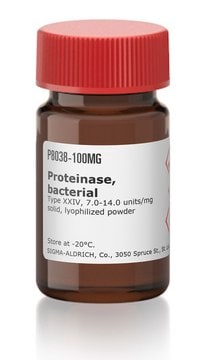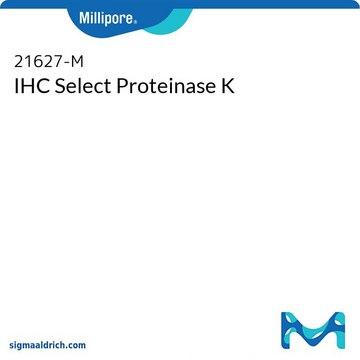1.24568
Proteinase K
(from Tritirachium album) chromatographically purified lyophilized 30 mAnson-U/mg for biochemistry and molecular biology EC 3.4.21.14
Synonym(s):
Proteinase K from Tritirachium album, Tritirachium alkaline proteinase, Endopeptidase K
About This Item
Recommended Products
Quality Level
form
solid
mol wt
28.93 kDa
pH
6.2-6.8 (20 °C, 10 g/L in H2O)
density
1.1 g/cm3
bulk density
35 kg/m3
storage temp.
2-8°C
Looking for similar products? Visit Product Comparison Guide
Application
Removes endotoxins that bind to cationic proteins such as lysozyme and ribonuclease A.
Reported useful for the isolation of hepatic, yeast, and mung bean mitochondria
Determination of enzyme localization on membranes
Treatment of paraffin embedded tissue sections to expose antigen binding sites for antibody labeling.
Digestion of proteins from brain tissue samples for prions in Transmissible Spongiform Encephalopathies (TSE) research.
Biochem/physiol Actions
Analysis Note
Appearance (description): lyophilisate
Activity (hemoglobin; pH 7.5; 37 °C): ≥ 30.0 mAnsonU/mg
Spec. activity (calc. on protein): ≥ 40 mAnsonU/mg
DNases (Nicking activity; pBR 322; 6 h; 37 °C): not detectable
RNases (RNA; 2 h; 37°C): not detectable
Signal Word
Danger
Hazard Statements
Precautionary Statements
Hazard Classifications
Eye Irrit. 2 - Resp. Sens. 1 - Skin Irrit. 2 - STOT SE 3
Target Organs
Respiratory system
Storage Class Code
11 - Combustible Solids
WGK
WGK 1
Flash Point(F)
Not applicable
Flash Point(C)
Not applicable
Certificates of Analysis (COA)
Search for Certificates of Analysis (COA) by entering the products Lot/Batch Number. Lot and Batch Numbers can be found on a product’s label following the words ‘Lot’ or ‘Batch’.
Already Own This Product?
Find documentation for the products that you have recently purchased in the Document Library.
Customers Also Viewed
Our team of scientists has experience in all areas of research including Life Science, Material Science, Chemical Synthesis, Chromatography, Analytical and many others.
Contact Technical Service








